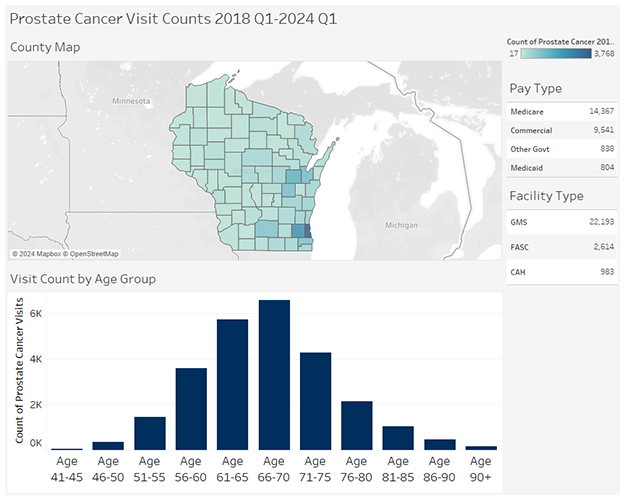Click here to view past issues
IN THIS ISSUE
- Wisconsin Medicaid Director Joins WHA Public Policy Council to Discuss Provider Rates, Maternal Health Transformation
- WHA Seeking Nominations for Annual Awards and 2025 Board of Directors – Deadline Extended to Sept. 13
- Fast Facts from the WHA Information Center: September is Prostate Cancer Awareness Month
EDUCATION EVENTS
Aug. 8, 2025
WHA Financial WorkshopSep. 17, 2025
2025 Annual Wisconsin Organization of Nurse Leaders ConferenceJan. 28, 2026
2026 WHA Health Care Leadership AcademyClick here to view education event calendar
View more issues of The Valued Voice
Sign Up for WHA's Newsletter
Fast Facts from the WHA Information Center: September is Prostate Cancer Awareness Month
September is known as Prostate Cancer Awareness Month to bring attention to this cancer in the United States. Prostate cancer is the second leading cause of death in men after lung cancer. The prostate gland is found only in men below the bladder. The Center for Disease Control and Prevention states that 13 out of 100 American men will be diagnosed with prostate cancer in their lifetime. In 2021, the number of new prostate cases in the United States was 236,659. According to the American Cancer Society, 1 in 41 men will die of prostate cancer, but the death rate has decreased by almost half from 1993 to 2013. This is most likely due to increased screenings and treatment advances. In more recent years, however, there has been a slight uptick in case numbers. The most common risk factor for being diagnosed is age—the older a man is, the greater chance of prostate cancer.
The WHA Information Center analyzed prostate cancer related visits from the past five years. The average age of patients visiting for prostate related cancer is 67 years old. The American Cancer Society states that the chance of being diagnosed increases dramatically after age 50 and almost 6 in 10 cases are found in men 65 years and older. Since 2018, there has been a slow rise in visits related to prostate cancer in Wisconsin, which follows the national trend. African Americans have a high rate of visiting for prostate cancer. Outpatient facilities saw by far the highest number of visit counts, followed by inpatient.
 Here are some of the most common risk factors for men to develop prostate cancer from the American Cancer Society:
Here are some of the most common risk factors for men to develop prostate cancer from the American Cancer Society:
- Age: the chance of being diagnosed with prostate cancer rises rapidly after age 50.
- Race/Ethnicity: African American men and Caribbean men of African ancestry are more likely to develop prostate cancer than men of other races. When it does develop in these men, they tend to be younger. Prostate cancer occurs less often in Asian American, Hispanic, and Latino men.
- Geography: Prostate cancer is more commonly found in North America, Australia, northwestern Europe, and some Caribbean islands. It is less common in Asian, Africa, Central and South America.
- Family History: The risk for developing is higher for men who have relatives diagnosed with prostate cancer. Having a father or brother with prostate cancer more than doubles a man’s risk of developing this disease.
Fast Facts from the WHA Information Center: September is Prostate Cancer Awareness Month
September is known as Prostate Cancer Awareness Month to bring attention to this cancer in the United States. Prostate cancer is the second leading cause of death in men after lung cancer. The prostate gland is found only in men below the bladder. The Center for Disease Control and Prevention states that 13 out of 100 American men will be diagnosed with prostate cancer in their lifetime. In 2021, the number of new prostate cases in the United States was 236,659. According to the American Cancer Society, 1 in 41 men will die of prostate cancer, but the death rate has decreased by almost half from 1993 to 2013. This is most likely due to increased screenings and treatment advances. In more recent years, however, there has been a slight uptick in case numbers. The most common risk factor for being diagnosed is age—the older a man is, the greater chance of prostate cancer.
The WHA Information Center analyzed prostate cancer related visits from the past five years. The average age of patients visiting for prostate related cancer is 67 years old. The American Cancer Society states that the chance of being diagnosed increases dramatically after age 50 and almost 6 in 10 cases are found in men 65 years and older. Since 2018, there has been a slow rise in visits related to prostate cancer in Wisconsin, which follows the national trend. African Americans have a high rate of visiting for prostate cancer. Outpatient facilities saw by far the highest number of visit counts, followed by inpatient.
 Here are some of the most common risk factors for men to develop prostate cancer from the American Cancer Society:
Here are some of the most common risk factors for men to develop prostate cancer from the American Cancer Society:
- Age: the chance of being diagnosed with prostate cancer rises rapidly after age 50.
- Race/Ethnicity: African American men and Caribbean men of African ancestry are more likely to develop prostate cancer than men of other races. When it does develop in these men, they tend to be younger. Prostate cancer occurs less often in Asian American, Hispanic, and Latino men.
- Geography: Prostate cancer is more commonly found in North America, Australia, northwestern Europe, and some Caribbean islands. It is less common in Asian, Africa, Central and South America.
- Family History: The risk for developing is higher for men who have relatives diagnosed with prostate cancer. Having a father or brother with prostate cancer more than doubles a man’s risk of developing this disease.
IN THIS ISSUE
- Wisconsin Medicaid Director Joins WHA Public Policy Council to Discuss Provider Rates, Maternal Health Transformation
- WHA Seeking Nominations for Annual Awards and 2025 Board of Directors – Deadline Extended to Sept. 13
- Fast Facts from the WHA Information Center: September is Prostate Cancer Awareness Month

